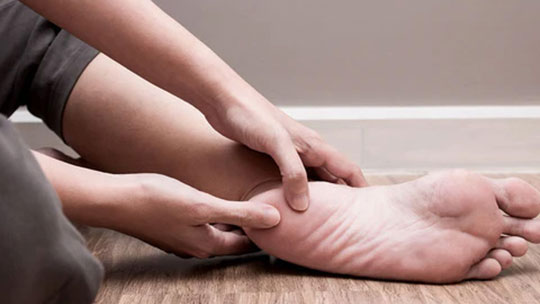Plantar Fasciitis
Plantar fasciitis is pain and inflammation of the thick tissue, called the plantar fascia, on the bottom of the foot. This thick tissue connects the heel bone to the toes and creates the arch of the foot.
Plantar fasciitis is pain and inflammation of the thick tissue, called the plantar fascia, on the bottom of the foot. This thick tissue connects the heel bone to the toes and creates the arch of the foot.
Plantar fasciitis is one of the most common causes of heel pain
Heel spurs are often experienced in conjunction with plantar fasciitis.
WHAT CAUSES PLANTAR FASCIITIS?
Plantar fasciitis is experienced when the plantar fascia, the thick band of tissue on the bottom of the foot, is overstretched or overused. Possible causes of this overuse include:
- Flat feet or high arches
- Obesity or rapid weight gain
- Long distance running
- Tight Achilles tendon
- Shoes with poor arch support or soft soles
HOW DO I KNOW IF I HAVE PLANTAR FASCIITIS?
WHAT ARE THE SYMPTOMS OF PLANTAR FASCIITIS?
- Pain and stiffness on the bottom of the heel
- Dull or sharp pain located at the bottom of the foot in addition to an ache or burning sensation
- Patients with plantar fasciitis often describe pain when they first wake up in the morning and take a few steps, pain that is worse with prolonged standing or physical activity, or pain that is worse when one takes the first few steps after sitting for a long period of time
- Pain that either develops in an intense, rapid time-frame or more slowly over a longer period of time
HOW IS PLANTAR FASCIITIS DIAGNOSED?
The physician will conduct a physical examination that will discover if there is any of the following:
- Tenderness on the bottom of your foot
- Flat feet or high arches
- Swelling or redness of the foot
- Stiffness or tightness of the arch of your foot.
X-rays might also be taken to discover if you have a heel spur or any other problems.
WHAT CAN I DO FROM HOME FOR PLANTAR FASCIITIS?
WHAT CAN I DO TO PREVENT PLANTAR FASCIITIS?
- Keep your Achilles tendon and calf muscles flexible
- Make sure you stretch your muscles properly before intense exercise and avoid constantly overusing your muscles
- Wear supportive shoes
WHAT TREATMENTS CAN I DO FROM HOME FOR PLANTAR FASCIITIS?
There are several treatments available for relief of plantar fasciitis and pain, including:
- Taking ibuprofen to reduce pain and inflammation
- Heel stretching exercises
- Resting as much as possible, for at least a week
- Wear shoes with good support and cushion.
You can also follow these steps to relieve pain from plantar fasciitis:
- Apply ice to the area twice a day for 10 minutes
- Use a heel cup in your shoes to reduce pressure on the heels by adding extra shock absorption.
- Night splints will maintain the length of the muscle so it doesn’t tighten up overnight and will allow for it to heal.
WHEN SHOULD I SEE A DOCTOR FOR PLANTAR FASCIITIS?
You should see a doctor when heel pain becomes repetitive and bothersome.
TREATMENTS YOUR DOCTOR MAY RECOMMEND FOR PLANTAR FASCIITIS
If the treatments mentioned in the previous section don’t work, your doctor may suggest the following:
- A boot cast for 3-6 weeks.
- Orthotics
- Steroid shots or injections into the heel.
- Surgical procedures might be necessary to release the tight tissue.

